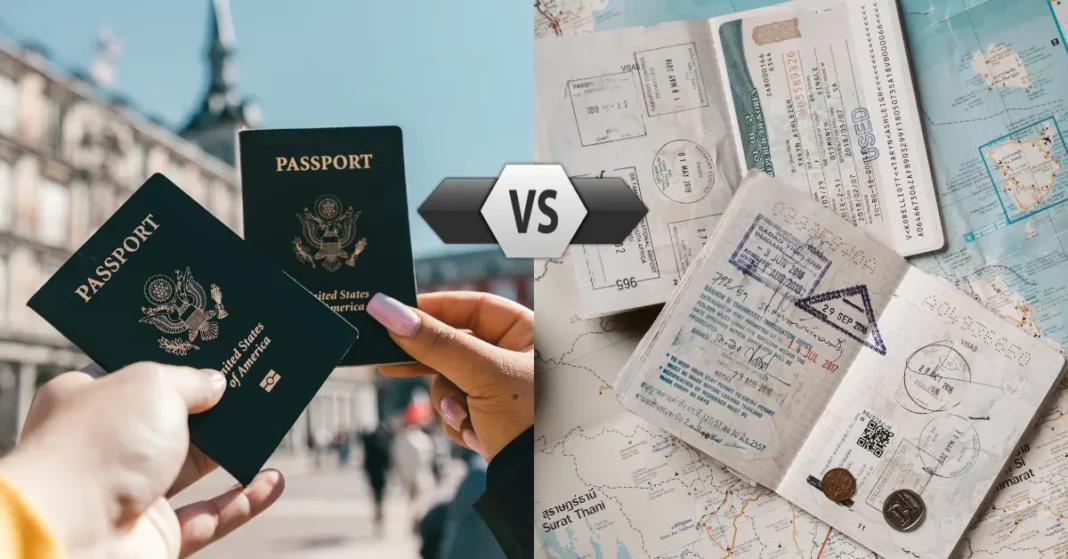Travel has been an integral part of human history, facilitating not just the exchange of goods, but also cultures, ideas, and innovations. In today’s interconnected world, international travel requires adherence to a structured set of rules and documentation. Among these necessary documents are passports and visas, each serving a distinct yet critical role in global mobility.
A passport, issued by a traveler’s home country, provides identification and is a prerequisite for leaving and re-entering one’s nation. On the other hand, a visa is a conditional authorization granted by a destination country that allows a foreigner to enter, remain within, or leave its territory. Understanding the nuanced differences and functions of these two travel documents is vital for anyone looking to explore the world beyond their national borders.
Table of Contents
Defining Passports and Visas
Passports and visas are essential documents used in international travel, but they serve different purposes and possess distinct legal implications.
A passport is issued by an individual’s country of citizenship. It acts as an official government identification, proving the holder’s identity and nationality while granting them the right to travel under the protection of their home country. Functionally, it serves as a prerequisite for international travel, akin to a key that unlocks the ability to cross borders.
Conversely, a visa is a conditional authorization granted by a country to a foreigner, allowing them to enter, remain within, or leave that country. Visas typically include limits on the duration of the foreigner’s stay, territory within the country they may enter, the dates they may enter, the number of permitted visits, or an individual’s right to work in the country.
Hence, while a passport certifies one’s right to travel from their sovereign entity, a visa is contingent upon the destination country’s immigration laws and is, in essence, a privilege rather than a right.
In legal terms, holding a valid passport from one’s country typically confers the right to return to that country, whereas visas are discretionary permits that may be revoked or denied by the issuing state based on its legal framework and assessments of the visa holder or applicant. Moreover, both documents must meet international standards as well as the specific requirements dictated by the issuing and receiving countries.
It is crucial to understand that while a passport validates identity and nationality, a visa reflects a host of considerations, including the purpose of the visit, international agreements, and security concerns—all of which inform the legal and functional distinctions between these two critical travel documents.
The Functionality and Limitations of Visas and Passports
In the orchestrated ballet of international travel and border security, the individual journey begins long before a traveler approaches the border, manifesting in the vetting processes enacted by various governments. Such scrutiny emphatically underscores the role of biometrics and technological advancements in enhancing border security and verifying traveler identity.
Advancements in digital technology have permitted the integration of biometric identifiers—such as fingerprints, facial recognition, and iris scans—into the infrastructure of passports and visa systems.
These biometric modalities serve as unique personal identifiers, immutable and individual, thus reducing incidences of fraud and impersonation. Upon arrival at a port of entry, border control officers deploy sophisticated systems to cross-reference the biometric data encoded within passports with the traveler’s live biometrics and international databases. This checkpoint acts as a fortification against unauthorized entry, ensuring that only those who have been vetted and granted access by the host nation are permitted to cross its thresholds.
To fortify international cooperation and heighten global security standards, countries adhere to multinational agreements, such as those outlined by the International Civil Aviation Organization (ICAO). Such agreements engender uniformity in security features of travel documents, allowing for a seamless interchange of information and recognition across borders.
This collaboration is paramount in thwarting transnational threats and aiding in the prevention of undesirable individuals traversing international barriers, thereby contributing to the integrity and safety of nations within the global context. Through these multifaceted measures, passports and visas play an instrumental role in constructing a formidable bulwark to uphold the sovereignty and security of countries worldwide.
Interdependence of Visa and Passport during Cross-border Movement
The interconnectedness of passports and visas is a topic of profound importance in the realm of international mobility and security. For instance, the evolution of biometric technology has become a cornerstone of modern travel document authentication, which serves to enhance border security and operational efficiency.
The incorporation of biometric identifiers—such as fingerprints, facial recognition, and iris scans—into passports and visa systems signifies a paradigm shift in the validation of individuals crossing international borders. Through such advancements, the integrity of travel documents is fortified, engendering a robust barrier against deceptive practices like fraud and impersonation.
As individuals traverse different sovereignties, the cross-referencing of biometrics at entry and exit points emerges as an essential component in maintaining secure borders. It is the merging of technology and international policy that enables authorities to swiftly confirm the authenticity of a traveler’s credentials, thereby expediting legitimate travel while impeding illicit entry.
This effort necessitates a certain level of international collaboration; countries must engage in reciprocal agreements and share pertinent data to counter multifarious transnational threats effectively. Adopting uniform security standards across international travel documents is not a mere procedural exercise but a collective defense against the exploitation of disparate security regimes.
Furthermore, the role of passports and visas extends beyond the facilitation of tourism and business—it is a reflection of a nation’s sovereignty and its prerogative to maintain security within its borders. Legal instruments such as visas are pivotal in ensuring that individuals entering the country align with national interests and do not pose a security risk.
It is the diligent application of these security measures, paired with international cooperation, that upholds the sanctity of state borders and deters the traversal of undesirable entities. Hence, the instruments of international mobility serve as bastions of a nation’s sovereignty, even in the era of burgeoning globalization and interconnectedness.
As we navigate through the complexities of international borders and the myriad of regulations that govern them, it becomes evident that passports and visas are not just mere travel formalities but central elements of global security and diplomacy. These documents embody a delicate balance between sovereign rights and mutual trust among nations, exemplified by their joint role in permitting individuals to explore beyond the confines of their homeland.
By appreciating the intricacies of passports and visas, travelers are better equipped to partake in the grand tapestry of a global movement, ensuring their journeys are conducted within the frameworks of legality and mutual respect that unite our diverse world.
Also Read: How long does it take to get a passport?





